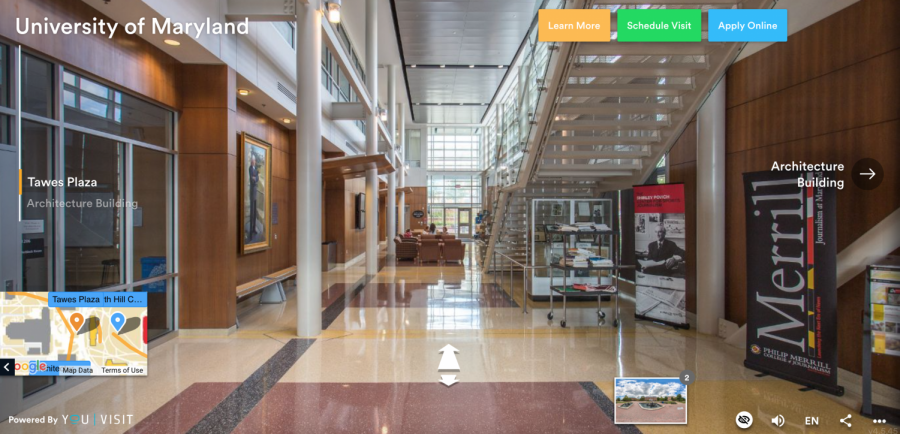In-person college visits are moved to virtual to contain the spread of COVID-19
YouVisit offers students the ability to virtually tour campuses and buildings of colleges they want, like the local University of Maryland College Park.
February 17, 2021
College visits– a crucial part of picking the right school for you. The graduating classes of 2021 and 2022 are forced to find alternatives to seeing the colleges that are at the top of their lists in-person, as the COVID-19 pandemic steadily tears its way into the normalcy of college search traditions.
In response to the canceling of on-campus tours, colleges now offer online 360-degree cameras and interactive videos to assist their upcoming students, but is that really enough to determine if a college is right for you?
“Tools that are given to students by our counselors, like Naviance, are always helpful in the college search process,” junior Torie Tran said. “Those features may be helpful for finding information about schools; however, it isn’t something new that helps with the obstacles against in person college visits.”
It may be easier and more efficient to do research online, but there is only so much you can learn about an environment from a distance. Depending on the student, college is an experience that will last up to four years or more. Judging a school from behind a screen can only tell you so much about the energy and environment that exists on a physical campus.
According to a poll conducted by the WCHS Observer, 82 percent of students preferred in-person college visits over 18 percent of students that did not.
“You really can’t appreciate the aspects of a campus with a virtual visit,” junior Elisa Zoltick said. “Being on campus in person allows for a more realistic view of the environment and also its surrounding community.”
Most colleges and universities require their freshman to live on campus for their first year at the school. Getting an idea of what a dorm room or communal space looks like from pictures is not enough to tell a student if those circumstances are compatible with their standards.
“Making a decision is a lot harder because being on campus is probably the most important part next to our classes,” Tran said. “Not seeing where we will be staying for the next four years will definitely make choosing where I want to go a lot more difficult.”
Websites like YouVisit offer virtual reality tours to simulate walking around on campus and getting familiar with the area of the schools. CampusTours offers demographics and detailed information on tuition, accepted students, enrollment specifics and even the region and setting of specific schools.
“COVID-19 has definitely made visiting colleges easier because all you need to do is join a zoom in order to learn about a college.” Zoltick said.
Getting a hold of a counselor or admissions officer could be stressful considering that the only form of communication students have with the colleges they want to attend is email. During a physical visit, there is always a person who will answer your personal questions without the delay of waiting for a response back from an officer.
“I’ve never been on a college visit because of everything that is going on,” Tran said. “The focus is to get the genuine feel of the college, and to be there to see if you can imagine yourself in that same atmosphere, which is difficult without actually being present in that environment.”
College visits are still something schools are trying to simulate in order to create a similar experience that others had before the pandemic when students could get insider info on details you may not be able to find online.
“Obviously, you are not getting the same experience as you would if you were on campus, but that is just the sacrifice we have to make,” Zoltick said.


